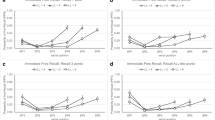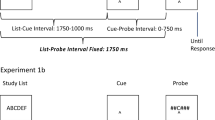Abstract
When Ss name the item that follows a test item in a short recently memorized list, their mean reaction-time (\(\overline {\rm RT}\)) increases linearly with list length. The linearity and slope of the function, and the effect of the test item’s serial position, imply that the test item is located in the memorized list by an internal self-terminating scanning process whose average rate is about four items/sec.
Article PDF
Similar content being viewed by others
Explore related subjects
Discover the latest articles and news from researchers in related subjects, suggested using machine learning.Avoid common mistakes on your manuscript.
References
Rock, I. A neglected aspect of the problem of recall: The Höffding function. In J. M. Scher (Ed.), Theories of the mind. New York: Free Press, 1962.
Sternberg, S. High-speed scanning in human memory. Science, 1966, 153, 652–654.
Sternberg, S. Two operations in character recognition: Some evidence from reaction-time measurements. Percept. & Psychophys., 1967, 2, 45–53.
Author information
Authors and Affiliations
Additional information
1. Supported in part by NSP grant GB-1172 to the University of Pennsylvania. I thank M. and R. Teghtsoonian, C. S. Harris, J. Krauskopf, and H. Savin for helpful discussions.
Rights and permissions
About this article
Cite this article
Sternberg, S. Retrieval of contextual information from memory. Psychon Sci 8, 55–56 (1967). https://doi.org/10.3758/BF03330664
Published:
Issue Date:
DOI: https://doi.org/10.3758/BF03330664




